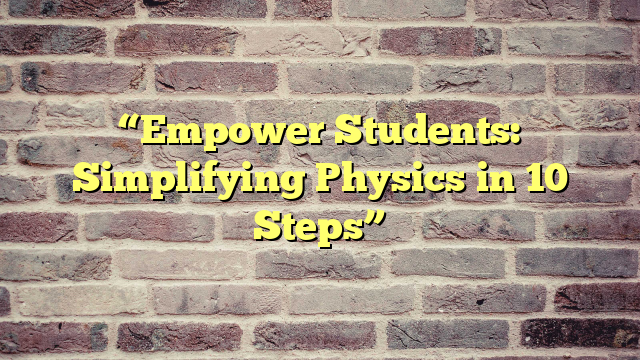Empower Students: Simplifying Physics in 10 Steps
Physics is a subject that is often feared by students due to its complex theories and equations. However, with the right approach, Physics can be simplified and made easier for students to understand. In this article, we will discuss 10 steps that can help empower students and make physics less intimidating.
Step 1: Start with the Basics – Understanding the Fundamentals
The first step to simplifying Physics is to have a strong foundation in its fundamentals. Students must understand the basic concepts and principles before moving on to more complex topics. This includes understanding the units of measurement, vectors, and Newton’s laws of motion. By establishing a strong foundation, students will have an easier time grasping more advanced concepts.
Step 2: Visualize the Concepts
One of the biggest challenges students face in Physics is understanding and visualizing abstract concepts. To overcome this, teachers can use visual aids such as diagrams, animations, and videos to help students visualize the concepts. This will make it easier for students to understand and remember the concepts.
Step 3: Use Real-World Examples
Physics is all around us, and it is essential to make students realize this. By using real-world examples, students can relate to the concepts being taught. For instance, the concept of force can be demonstrated by using a seesaw or a pulley. This will not only make learning more interesting but also help students understand the practical applications of Physics.
Step 4: Break Down Complex Problems into Smaller Parts
Complex problems can be overwhelming and demotivating for students. To avoid this, teachers can break down complex problems into smaller parts and explain each step in detail. This will make it easier for students to understand and solve the problem.
Step 5: Encourage Active Learning
Active learning involves engaging students in the learning process rather than just passively listening to lectures. Teachers can encourage active learning by asking students to solve problems, participate in class discussions, and conduct experiments. This will not only make learning more fun but also help students retain the information better.
Step 6: Practice, Practice, Practice
The key to mastering any subject, including Physics, is practice. Students must be encouraged to practice solving problems regularly. This will not only help them understand the concepts better but also improve their problem-solving skills. Teachers can provide students with practice questions and conduct regular quizzes to assess their understanding.
Step 7: Make Use of Technology
In this digital age, technology can be a powerful tool for simplifying Physics. Various educational apps, simulations, and virtual labs are available which can make learning Physics more interactive and engaging. Teachers can also use online platforms to share resources and assignments with students, making learning more convenient and accessible.
Step 8: Connect with Peers
Group study sessions can be beneficial for students as they can learn from their peers and clarify any doubts they may have. By discussing and solving problems together, students can gain a better understanding of the subject. Teachers can also encourage students to form study groups and facilitate group discussions.
Step 9: Use Mnemonic Devices
Mnemonic devices are memory aids that can help students remember complex concepts or formulas. For instance, the acronym “SOHCAHTOA” can be used to remember the trigonometric ratios (sine, cosine, tangent). Teachers can introduce students to different mnemonic devices and encourage them to come up with their own.
Step 10: Provide Continuous Support and Feedback
Last but not least, continuous support and feedback are crucial for empowering students and making them confident in Physics. Teachers must be approachable and provide students with the necessary support and guidance to overcome any difficulties they may face. Regular feedback can also help students identify their strengths and weaknesses and work on improving them.
In conclusion, Physics can be a challenging subject, but by following these 10 steps, students can be empowered and find it easier to understand. Teachers play a crucial role in simplifying Physics and making it more interesting and accessible for students. With the right approach and continuous support, students can overcome their fear of Physics and develop a love for the subject.

